John Jeremy Pierce (born 1941) is an American science fiction editor, historian and critic.
John Jeremy Pierce (born 1941) is an American science fiction editor, historian and critic.
Pierce published the science fiction fanzine Renaissance from 1968 through 1974, and was an outspoken critic of the New Wave. [1] In the 1970s he edited The Best of Murray Leinster , The Best of Cordwainer Smith and The Best of Raymond Z. Gallun for Del Rey Books. In 1977–78, he was named editor of Galaxy at a time when the magazine was in financial trouble, an experience he later recounted in Thirteen Months of Torment . [2]
After leaving Galaxy, Pierce focused on a four-volume (1987–1994) critical history of science fiction under the general title, "A Study in Imagination and Evolution", adopting a conceptual framework, as opposed to a strictly chronological approach, and using parallels with biological evolution and dialectics to characterize the evolution of the genre as a whole. As of 2012, he was working on a revised and updated version.
He has written critical essays and book introductions on Cordwainer Smith, and essays on Twin Peaks and The X-Files for the fanzines Wrapped in Plastic and Spectrum and has had other articles published in The New York Review of Science Fiction and Science Fiction Studies. Besides works related to science fiction and popular culture, he is the author of a family history, The Children of Levi Peacock (2002).
Pierce is the son of John Robinson Pierce, the engineer, scientist (and science fiction writer) who coined the word "transistor". [3] He is married to Marcia (née Feinbaum), widow of Arata Suzuki, and lives in Ramsey, New Jersey. He works as an editor at two trade magazines, Private Label and Quick Frozen Foods International . [4]

Paul Myron Anthony Linebarger, better known by his pen-name Cordwainer Smith, was an American author known for his science fiction works. Linebarger was a US Army officer, a noted East Asia scholar, and an expert in psychological warfare. Although his career as a writer was shortened by his death at the age of 53, he is considered one of science fiction's more talented and influential authors.

A fanzine is a non-professional and non-official publication produced by enthusiasts of a particular cultural phenomenon for the pleasure of others who share their interest. The term was coined in an October 1940 science fiction fanzine by Russ Chauvenet and first popularized within science fiction fandom, and from there the term was adopted by other communities.
The New Wave was a science fiction style of the 1960s and 1970s, characterized by a great degree of experimentation with the form and content of stories, greater imitation of the styles of non-science fiction literature, and an emphasis on the psychological and social sciences as opposed to the physical sciences. New Wave authors often considered themselves as part of the modernist tradition of fiction, and the New Wave was conceived as a deliberate change from the traditions of the science fiction characteristic of pulp magazines, which many of the writers involved considered irrelevant or unambitious.

Raphael Aloysius "R. A." Lafferty was an American science fiction and fantasy writer known for his original use of language, metaphor, and narrative structure, Lafferty also wrote a set of four autobiographical novels, a history book, and several novels of historical fiction.

Damon Francis Knight was an American science fiction author, editor, and critic. He is the author of "To Serve Man", a 1950 short story adapted for The Twilight Zone. He was married to fellow writer Kate Wilhelm.
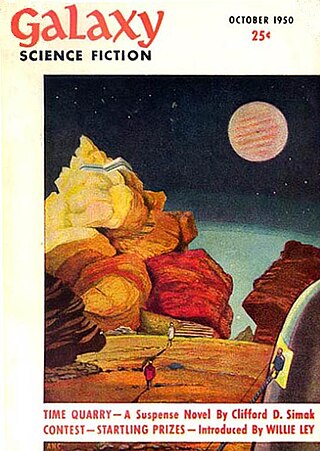
Galaxy Science Fiction was an American digest-size science fiction magazine, published in Boston from 1950 to 1980. It was founded by a French-Italian company, World Editions, which was looking to break into the American market. World Editions hired as editor H. L. Gold, who rapidly made Galaxy the leading science fiction magazine of its time, focusing on stories about social issues rather than technology.
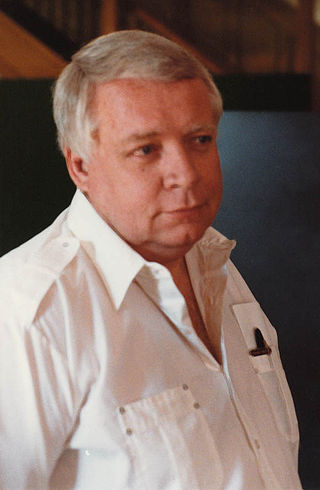
Algirdas Jonas "Algis" Budrys was a Lithuanian-American science fiction author, editor, and critic. He was also known under the pen names Frank Mason, Alger Rome, John A. Sentry, William Scarff, and Paul Janvier. He is known for the influential 1960 novel Rogue Moon.
Damien Francis Broderick is an Australian science fiction and popular science writer and editor of some 74 books. His science fiction novel The Dreaming Dragons (1980) introduced the trope of the generation time machine, his The Judas Mandala (1982) contains the first appearance of the term "virtual reality" in science fiction, and his 1997 popular science book The Spike was the first to investigate the technological singularity in detail.
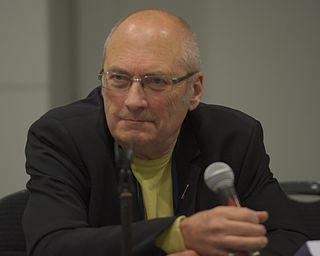
John Frederick Clute is a Canadian-born author and critic specializing in science fiction and fantasy literature who has lived in both England and the United States since 1969. He has been described as "an integral part of science fiction's history" and "perhaps the foremost reader-critic of sf in our time, and one of the best the genre has ever known." He was one of eight people who founded the English magazine Interzone in 1982.

Patrick James Nielsen Hayden, is an American science fiction editor, fan, fanzine publisher, essayist, reviewer, anthologist, teacher and blogger. He is a World Fantasy Award and Hugo Award winner, and is an editor and the Manager of Science Fiction at Tor Books.
Edgar Pangborn was an American writer of mystery, historical, and science fiction.

Past Master is a science fiction novel by American writer R. A. Lafferty, first published in 1968. The novel follows the attempt of a future Utopian society in preventing its decline, by bringing Sir Thomas More to the year 2535.
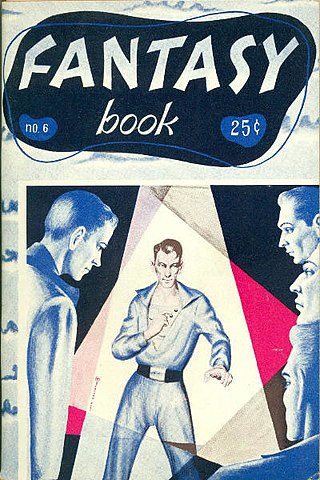
"Scanners Live in Vain" is a science fiction short story by American writer Cordwainer Smith. It was the first story in Smith's Instrumentality of Mankind future history to be published and the first story to appear under the Smith pseudonym. It first appeared in the semi-professional magazine Fantasy Book.

Terence William (Terry) Dowling, is an Australian writer and journalist. He writes primarily speculative fiction though he considers himself an "imagier" – one who imagines, a term which liberates his writing from the constraints of specific genres. He has been called "among the best-loved local writers and most-awarded in and out of Australia, a writer who stubbornly hews his own path ."
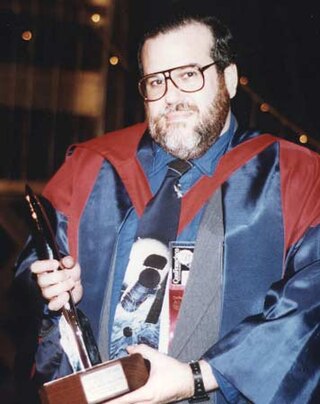
Andrew Ian Porter is an American editor, publisher and active science fiction fan.
Michael D. C. Drout is an American Professor of English and Director of the Center for the Study of the Medieval at Wheaton College. He is an author and editor specializing in Anglo-Saxon and medieval literature, science fiction and fantasy, especially the works of J. R. R. Tolkien and Ursula K. Le Guin.
Science fiction studies is the common name for the academic discipline that studies and researches the history, culture, and works of science fiction and, more broadly, speculative fiction.

Fantasy Book was a semi-professional American science fiction magazine that published eight issues between 1947 and 1951. The editor was William Crawford, and the publisher was Crawford's Fantasy Publishing Company, Inc. Crawford had problems distributing the magazine, and his budget limited the quality of the paper he could afford and the artwork he was able to buy, but he attracted submissions from some well-known writers, including Isaac Asimov, Frederik Pohl, A. E. van Vogt, Robert Bloch, and L. Ron Hubbard. The best-known story to appear in the magazine was Cordwainer Smith's first sale, "Scanners Live in Vain", which was later included in the first Science Fiction Hall of Fame anthology, and is now regarded as one of Smith's finest works. Jack Gaughan, later an award-winning science fiction artist, made his first professional sale to Fantasy Book, for the cover illustrating Smith's story.

Karen L. Hellekson is an American author and scholar who researches science fiction and fan studies. In the field of science fiction, she is known for her research on the alternate history genre, the topic of her 2001 book, The Alternate History: Refiguring Historical Time, and has also published on the author Cordwainer Smith. In fan studies, she is known for her work on fan fiction and the culture of the fan community. She has co-edited two essay collections on fan fiction with Kristina Busse, and in 2008, co-founded the academic journal, Transformative Works and Cultures, also with Busse.

The Best of Cordwainer Smith is a collection of science fiction short stories by American author Cordwainer Smith, edited by J. J. Pierce. It was first published in hardback by Nelson Doubleday in July 1975 and in paperback by Ballantine Books in September of the same year as a volume in its Classic Library of Science Fiction. The Ballantine edition was reprinted in October 1977 and July 1985. Phoenix Pick issued a new edition in trade paperback and ebook in April, 2017. A British paperback edition under the alternative title The Rediscovery of Man was published by Gollancz in June 1988, and reissued in 1999, 2003, and 2010; Gollancz also brought out hardcover and ebook versions in September 1988 and November 2012, respectively. The book has also been translated into German.